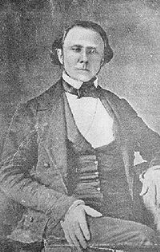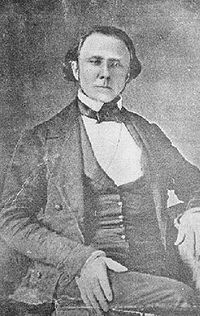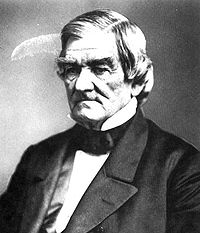
Cherokee in the American Civil War
Encyclopedia
Cherokee
in the American Civil War
were active in two major regions. In the east, Confederate Cherokee led by William Holland Thomas
hindered Union forces trying to use the Appalachia
n mountain passes of western North Carolina
and eastern Tennessee
. Out west, Stand Watie
, who was 3/4 Cherokee, led Confederate forces in the Indian Territory
, in what is now the state of Oklahoma
.
 The Thomas' Legion
The Thomas' Legion
, led by William H. Thomas, European-American who was adopted Cherokee, were originally stationed outside Knoxville, Tennessee
at Strawberry Plains, Tennessee
. Their primary duty was to protect the Alum Cave, and harass Union troops that invaded Tennessee. While briefly working around Chattanooga, Tennessee
in June 1862, Thomas personally captured a Union Soldier, after which each of his men vowed to capture at least one "Yankee" before the war was over.
The Legion would become infamous due to their actions on September 15, 1862. While trying to stop a Union advance through Baptist Gap, a popular leader among the Cherokee, Astoogahtogeh, was killed leading a charge. Enraged, the remaining Cherokee were driven to avenge him. In retaliation for Astoogahtogeh's death, the Cherokee scalped the dead Union soldiers after the battle. After the event was reported in newspapers, Union soldiers would fear the Cherokee, but Thomas feared for the reputation of the Cherokee, as he did not want his people seen as barbaric. The scalps were sent to be buried with the soldiers they originally came from.
After a number of Thomas' men were captured in February 1864, some were convinced by the Union that they were fighting for slavery
, and thereafter fought for the Union. Others convinced their captors they also would defect to the Union side, but instead went back to Thomas and told him Union officials offered $5,000 for Thomas' scalp. After this, many of his men were sent to fight in Virginia, some of whom were present at Appomattox Court House
for General Robert E. Lee
's surrender. The rest of the Legion continued to fight until surrendering along with the commanding officer of the District of Western North Carolina to the Union commander they had captured on 10 May 1865.
 In the west, the Cherokees blamed the federal government and former United States President Andrew Jackson
In the west, the Cherokees blamed the federal government and former United States President Andrew Jackson
for the Trail of Tears. Also, they had adopted Southern ways before their removal from their Appalachia home, including the practice of keeping blacks as slaves. So, the western Cherokee were already sympathetic towards the South when in 1860 William Seward
, campaigning on behalf of Abraham Lincoln
, said that Lincoln would open the Indian Territory for white settlement.
Chief of the Cherokee John Ross
was adamant that the Union was not dissolved. However, another leader of the Cherokee, Stand Watie
, was eager to join the Confederate cause, and on June 1, 1861, began recruiting for an army to assist the Southern cause. Full-blooded Cherokees tended to support Ross (who was actually 7/8 Scottish) while the mixed-blooded Cherokee supported the 3/4 Cherokee Stand Watie. Stand Watie in 1862 was elected Chief of the Southern Cherokee Nation.
For the duration of the war, a series of small battles were waged by Cherokees in the Indian Territory. Stand Watie officially became the last Confederate general to end fighting on June 25, 1865 at Fort Towson
, in the southeast portion of the Indian Territory. The terms of the armistice allowed Watie and his command, the First Indian Brigade of the Army of the Trans-Mississippi, to demobilize rather than surrender and go home with their arms.
outbreak following the war. Thomas and many of his followers were deeply in debt, to the point that the federal government recognized the eastern tribe as separate from the western tribe, and filed a lawsuit against the Cherokee's creditors, in effect leaving the protection of the Cherokee to the federal government.
In the west, at the end of the war, with the Union victorious, the Union Cherokee established policies that confiscated land from the Confederate Cherokee. The Federal government promised the Confederate Cherokee that the laws promoting the confiscation would be annulled. This was due to Indian Commissioner D.N. Cooley, who saw opportunities in splitting the factions of the Cherokee, as represented by Ross and Watie. Cooley even went as far as to portray Ross as a traitor, when Ross had always been a Union advocate. The Cherokee were forced to adopt their slaves into the tribe, and to allow settlement of their lands by whites. In effect, due to the Cherokee split and the maneuverings of Cooley, the Cherokee suffered the worst of Reconstruction.
Cherokee
The Cherokee are a Native American people historically settled in the Southeastern United States . Linguistically, they are part of the Iroquoian language family...
in the American Civil War
American Civil War
The American Civil War was a civil war fought in the United States of America. In response to the election of Abraham Lincoln as President of the United States, 11 southern slave states declared their secession from the United States and formed the Confederate States of America ; the other 25...
were active in two major regions. In the east, Confederate Cherokee led by William Holland Thomas
William Holland Thomas
William Holland Thomas was Principal Chief of the Eastern Band of Cherokee Indians and an officer in the Confederate States Army during the American Civil War....
hindered Union forces trying to use the Appalachia
Appalachia
Appalachia is a term used to describe a cultural region in the eastern United States that stretches from the Southern Tier of New York state to northern Alabama, Mississippi, and Georgia. While the Appalachian Mountains stretch from Belle Isle in Canada to Cheaha Mountain in the U.S...
n mountain passes of western North Carolina
North Carolina
North Carolina is a state located in the southeastern United States. The state borders South Carolina and Georgia to the south, Tennessee to the west and Virginia to the north. North Carolina contains 100 counties. Its capital is Raleigh, and its largest city is Charlotte...
and eastern Tennessee
Tennessee
Tennessee is a U.S. state located in the Southeastern United States. It has a population of 6,346,105, making it the nation's 17th-largest state by population, and covers , making it the 36th-largest by total land area...
. Out west, Stand Watie
Stand Watie
Stand Watie , also known as Standhope Uwatie, Degataga , meaning “stand firm”), and Isaac S. Watie, was a leader of the Cherokee Nation and a brigadier general of the Confederate States Army during the American Civil War...
, who was 3/4 Cherokee, led Confederate forces in the Indian Territory
Indian Territory
The Indian Territory, also known as the Indian Territories and the Indian Country, was land set aside within the United States for the settlement of American Indians...
, in what is now the state of Oklahoma
Oklahoma
Oklahoma is a state located in the South Central region of the United States of America. With an estimated 3,751,351 residents as of the 2010 census and a land area of 68,667 square miles , Oklahoma is the 28th most populous and 20th-largest state...
.
Eastern front

Thomas' Legion
Thomas' Legion, also known as Thomas' Legion of Cherokee Indians and Highlanders, Thomas' Legion of Indians and Highlanders, and the 69th North Carolina Regiment, was a unit of the Confederate Army in the American Civil War...
, led by William H. Thomas, European-American who was adopted Cherokee, were originally stationed outside Knoxville, Tennessee
Knoxville, Tennessee
Founded in 1786, Knoxville is the third-largest city in the U.S. state of Tennessee, U.S.A., behind Memphis and Nashville, and is the county seat of Knox County. It is the largest city in East Tennessee, and the second-largest city in the Appalachia region...
at Strawberry Plains, Tennessee
Strawberry Plains, Tennessee
Strawberry Plains is an unincorporated community straddling the boundary between Jefferson and Sevier and Knox counties in the U.S. state of Tennessee. The United States Geographic Names System classifies Strawberry Plains as a populated place....
. Their primary duty was to protect the Alum Cave, and harass Union troops that invaded Tennessee. While briefly working around Chattanooga, Tennessee
Chattanooga, Tennessee
Chattanooga is the fourth-largest city in the US state of Tennessee , with a population of 169,887. It is the seat of Hamilton County...
in June 1862, Thomas personally captured a Union Soldier, after which each of his men vowed to capture at least one "Yankee" before the war was over.
The Legion would become infamous due to their actions on September 15, 1862. While trying to stop a Union advance through Baptist Gap, a popular leader among the Cherokee, Astoogahtogeh, was killed leading a charge. Enraged, the remaining Cherokee were driven to avenge him. In retaliation for Astoogahtogeh's death, the Cherokee scalped the dead Union soldiers after the battle. After the event was reported in newspapers, Union soldiers would fear the Cherokee, but Thomas feared for the reputation of the Cherokee, as he did not want his people seen as barbaric. The scalps were sent to be buried with the soldiers they originally came from.
After a number of Thomas' men were captured in February 1864, some were convinced by the Union that they were fighting for slavery
Slavery
Slavery is a system under which people are treated as property to be bought and sold, and are forced to work. Slaves can be held against their will from the time of their capture, purchase or birth, and deprived of the right to leave, to refuse to work, or to demand compensation...
, and thereafter fought for the Union. Others convinced their captors they also would defect to the Union side, but instead went back to Thomas and told him Union officials offered $5,000 for Thomas' scalp. After this, many of his men were sent to fight in Virginia, some of whom were present at Appomattox Court House
Appomattox Court House
The Appomattox Courthouse is the current courthouse in Appomattox, Virginia built in 1892. It is located in the middle of the state about three miles northwest of the Appomattox Court House National Historical Park, once known as Clover Hill - home of the original Old Appomattox Court House...
for General Robert E. Lee
Robert E. Lee
Robert Edward Lee was a career military officer who is best known for having commanded the Confederate Army of Northern Virginia in the American Civil War....
's surrender. The rest of the Legion continued to fight until surrendering along with the commanding officer of the District of Western North Carolina to the Union commander they had captured on 10 May 1865.
Western front

Andrew Jackson
Andrew Jackson was the seventh President of the United States . Based in frontier Tennessee, Jackson was a politician and army general who defeated the Creek Indians at the Battle of Horseshoe Bend , and the British at the Battle of New Orleans...
for the Trail of Tears. Also, they had adopted Southern ways before their removal from their Appalachia home, including the practice of keeping blacks as slaves. So, the western Cherokee were already sympathetic towards the South when in 1860 William Seward
William H. Seward
William Henry Seward, Sr. was the 12th Governor of New York, United States Senator and the United States Secretary of State under Abraham Lincoln and Andrew Johnson...
, campaigning on behalf of Abraham Lincoln
Abraham Lincoln
Abraham Lincoln was the 16th President of the United States, serving from March 1861 until his assassination in April 1865. He successfully led his country through a great constitutional, military and moral crisis – the American Civil War – preserving the Union, while ending slavery, and...
, said that Lincoln would open the Indian Territory for white settlement.
Chief of the Cherokee John Ross
John Ross (Cherokee chief)
John Ross , also known as Guwisguwi , was Principal Chief of the Cherokee Native American Nation from 1828–1866...
was adamant that the Union was not dissolved. However, another leader of the Cherokee, Stand Watie
Stand Watie
Stand Watie , also known as Standhope Uwatie, Degataga , meaning “stand firm”), and Isaac S. Watie, was a leader of the Cherokee Nation and a brigadier general of the Confederate States Army during the American Civil War...
, was eager to join the Confederate cause, and on June 1, 1861, began recruiting for an army to assist the Southern cause. Full-blooded Cherokees tended to support Ross (who was actually 7/8 Scottish) while the mixed-blooded Cherokee supported the 3/4 Cherokee Stand Watie. Stand Watie in 1862 was elected Chief of the Southern Cherokee Nation.
For the duration of the war, a series of small battles were waged by Cherokees in the Indian Territory. Stand Watie officially became the last Confederate general to end fighting on June 25, 1865 at Fort Towson
Fort Towson
Fort Towson was a frontier outpost for Frontier Army Quartermasters along the Permanent Indian Frontier located about two miles northeast of the present community of Fort Towson, Oklahoma....
, in the southeast portion of the Indian Territory. The terms of the armistice allowed Watie and his command, the First Indian Brigade of the Army of the Trans-Mississippi, to demobilize rather than surrender and go home with their arms.
Aftermath
The eastern Cherokee faced a severe smallpoxSmallpox
Smallpox was an infectious disease unique to humans, caused by either of two virus variants, Variola major and Variola minor. The disease is also known by the Latin names Variola or Variola vera, which is a derivative of the Latin varius, meaning "spotted", or varus, meaning "pimple"...
outbreak following the war. Thomas and many of his followers were deeply in debt, to the point that the federal government recognized the eastern tribe as separate from the western tribe, and filed a lawsuit against the Cherokee's creditors, in effect leaving the protection of the Cherokee to the federal government.
In the west, at the end of the war, with the Union victorious, the Union Cherokee established policies that confiscated land from the Confederate Cherokee. The Federal government promised the Confederate Cherokee that the laws promoting the confiscation would be annulled. This was due to Indian Commissioner D.N. Cooley, who saw opportunities in splitting the factions of the Cherokee, as represented by Ross and Watie. Cooley even went as far as to portray Ross as a traitor, when Ross had always been a Union advocate. The Cherokee were forced to adopt their slaves into the tribe, and to allow settlement of their lands by whites. In effect, due to the Cherokee split and the maneuverings of Cooley, the Cherokee suffered the worst of Reconstruction.
See also
- Cherokee military historyCherokee military historyThe Cherokee people from the Southeastern United States and later Oklahoma and surrounding areas have a long military history. Since European contact, it has been documented through European records. Tribes and bands had numerous conflicts in the 18th century with European colonizing forces,...
- Southern Cherokee Nation of KentuckySouthern Cherokee Nation of KentuckyThe Southern Cherokee Nation of Kentucky claim descent from the Cherokee forcibly removed to Indian Territory in 1838, and to have first emerged as a distinct political faction known as the Treaty Party before the Trail of Tears, circa 1835. They report having fled Indian territory, after the...

